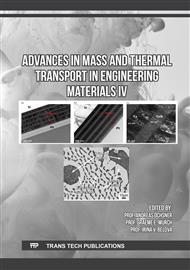[1]
A. P. Babichev, Basics of Vibration Technology, Edition DSTU, 2008, 40-44.
Google Scholar
[2]
Douglas C. Montgomery, Design and analysis of experiments, Publisher: JOHN WILEY & SONS, 5th Edition, p.2001.
Google Scholar
[3]
F. Hashimoto, Modeling and Optimization of Vibratory Finishing Process, CIRP, Ann. Manuf. Technol. 45 (1) (1996) 303–306.
DOI: 10.1016/s0007-8506(07)63068-6
Google Scholar
[4]
Surface treatments and coatings for tribological purposes, CETIM, GAMI, 1994 ISBN 2-85400-333-0
Google Scholar
[5]
A. P. Babichev, P.D. Motrenko, Using the Vibration technology for improving the surface quality and the mechanical characteristics, 2006.
Google Scholar
[6]
A. P. Babichev, improving the fatigue strength of non-ferrous materials by tribofinishing process, 2010.
Google Scholar
[7]
Jacques Goupy, Lee Creighton, Introduction to design of experiments, SAS Publishing, (2007)
Google Scholar
[8]
Alain Cornet, Jean-Paul Deville, Physics and surface engineering, 1998.
Google Scholar
[9]
Mohammad Reza Baghbanan, Akihiro Yabuki, Roland S. Timsit, Jan K. Spelt, Tribological behavior of aluminum alloys in a vibratory finishing process, Wear, 255 (2003), 1369-1379.
DOI: 10.1016/s0043-1648(03)00124-8
Google Scholar
[10]
Volker Schulze, Modern Mechanical Surface Treatment, Edition WILEY-VCH, 2006.
Google Scholar
[11]
Douglas C. Montgomery, Design and analysis of experiments, Publisher: JOHN WILEY & SONS, 5th Edition, 2001.
Google Scholar
[12]
Laroux. K. Gillespie, Mass Finishing Handbook, Edition Industrial Press New York, 2007.
Google Scholar
[13]
Laroux. K. Gillespie, Deburring and Edge Finishing, Handbook, Edition SME, 1999.
Google Scholar
[14]
S. Bagehorn, Application of mechanical surface finishing process for roughness reduction and fatigue improvement of additively manufactured Ti-6Al-4V parts, International Journal of Fatigue, Vol.102, pp.135-142, 2017.
DOI: 10.1016/j.ijfatigue.2017.05.008
Google Scholar
[15]
S. Wang, Experimental investigation of vibratory finishing of aluminium, WEAR, vol.243, pp.147-156, 2000.
Google Scholar
[16]
Escart Uhlmann, Investigation of material removal and surface topology formation in vibratory finishing, 6th CIRP, International Conference on High Performance Cutting, vol.14, pp.25-30, HPC2014, Berkeley, California, USA.
DOI: 10.1016/j.procir.2014.03.048
Google Scholar
[17]
Vigneashwara Pandiyan, High frequency and amplitude effects in vibratory media finishing, Elsevier, Procedia manufacturing, Vol.5, pp.546-557, 2016.
DOI: 10.1016/j.promfg.2016.08.045
Google Scholar
[18]
F. Salvatore, Experimental and numerical study of media action during tribofinishing in the case of SLM titanium parts, Procedia, vol.58, pp.451-456, 2017.
DOI: 10.1016/j.procir.2017.03.251
Google Scholar
[19]
V.Vijaraghavan, S. Castagne, measurement of surface characteristics of Ti6A14V aerospace engineering components in mass finishing process, Measurement, vol.115, pp.279-287, 2017.
DOI: 10.1016/j.measurement.2017.10.054
Google Scholar
[20]
I. Hilerioa, T. Mathia, Interface mass transfer during the tribofinishing process, Journal of Materials Processing Technology, 209 (2009) 6057–6061
DOI: 10.1016/j.jmatprotec.2009.08.012
Google Scholar
[21]
Jacques Goupy, Lee Creighton, Introduction to design of experiments, SAS Publishing, (2007)
Google Scholar
[22]
Jacques Goupy, Pratiquer les plans d'expériences, Dunod, (2005)
Google Scholar


